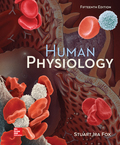
EBK HUMAN PHYSIOLOGY
15th Edition
ISBN: 9781260163049
Author: Fox
Publisher: MCGRAW HILL BOOK COMPANY
expand_more
expand_more
format_list_bulleted
Question
Chapter 8, Problem 13RA
Summary Introduction
To determine:
The location of supraoptic and paraventricular nuclei which synthesize antidiuretic hormone (ADH) and oxytocin.
Introduction:
There are various endocrine glands present in the body. The function/secretion of several glands is dependent on the stimulation from another gland. Water reabsorption in the kidneys is stimulated by ADH. The oxytocin hormone stimulates the contraction of the uterus during labor. ADH and oxytocin are stored in one gland and synthesized by another gland.
Expert Solution & Answer
Want to see the full answer?
Check out a sample textbook solution
Students have asked these similar questions
Please draw in the missing answer, thank you
Please fill in all blank questions, Thank you
please fill in missing parts , thank you
Chapter 8 Solutions
EBK HUMAN PHYSIOLOGY
Ch. 8 - Prob. 1CPCh. 8 - Describe the embryonic origin of the brain...Ch. 8 - Prob. 3aCPCh. 8 - Describe the locations and functions of the basal...Ch. 8 - Prob. 4aCPCh. 8 - Prob. 4bCPCh. 8 - Prob. 5CPCh. 8 - Prob. 6CPCh. 8 - Prob. 7aCPCh. 8 - Prob. 7bCP
Ch. 8 - Prob. 8aCPCh. 8 - Prob. 8bCPCh. 8 - Prob. 9CPCh. 8 - Prob. 10CPCh. 8 - Prob. 11aCPCh. 8 - List the tracts of the extrapyramidal system and...Ch. 8 - Prob. 12aCPCh. 8 - Prob. 12bCPCh. 8 - Prob. 1RACh. 8 - Prob. 2RACh. 8 - Prob. 3RACh. 8 - Prob. 4RACh. 8 - Prob. 5RACh. 8 - Prob. 6RACh. 8 - Prob. 7RACh. 8 - Prob. 8RACh. 8 - Prob. 9RACh. 8 - Prob. 10RACh. 8 - Prob. 11RACh. 8 - Prob. 12RACh. 8 - Prob. 13RACh. 8 - Prob. 14RACh. 8 - Prob. 15RACh. 8 - Prob. 16RACh. 8 - Prob. 17RACh. 8 - The thalamus has been described as a...Ch. 8 - Prob. 19RACh. 8 - Prob. 20RACh. 8 - Prob. 21RACh. 8 - Prob. 22RACh. 8 - Prob. 23RACh. 8 - Prob. 24RACh. 8 - State two reasons why researchers distinguish...Ch. 8 - Describe evidence showing that the hippocampus is...Ch. 8 - Prob. 27RACh. 8 - Prob. 28RACh. 8 - Prob. 29RACh. 8 - Recent studies suggest that medial temporal lobe...Ch. 8 - Much has been made (particularly by left-handers)...Ch. 8 - Prob. 32RACh. 8 - Prob. 33RACh. 8 - Neurologists have noticed that patients with...Ch. 8 - Prob. 35RACh. 8 - Prob. 36RACh. 8 - Table 7.3 (chapter 7) provides the axon diameters...Ch. 8 - Prob. 38RACh. 8 - Prob. 39RACh. 8 - Table 7.3 (chapter 7) provides the axon diameters...
Knowledge Booster
Learn more about
Need a deep-dive on the concept behind this application? Look no further. Learn more about this topic, biology and related others by exploring similar questions and additional content below.Similar questions
- please draw in the answers, thank youarrow_forwarda. On this first grid, assume that the DNA and RNA templates are read left to right. DNA DNA mRNA codon tRNA anticodon polypeptide _strand strand C с A T G A U G C A TRP b. Now do this AGAIN assuming that the DNA and RNA templates are read right to left. DNA DNA strand strand C mRNA codon tRNA anticodon polypeptide 0 A T G A U G с A TRParrow_forwardplease answer all question below with the following answer choice, thank you!arrow_forward
- please draw in the answeres, thank youarrow_forwardA) What is being shown here?B) What is indicated by the RED arrow?C) What is indicated by the BLUE arrow?arrow_forwardPlease identify the curve shown below. What does this curve represent? Please identify A, B, C, D, and E (the orange oval). What is occurring in these regions?arrow_forward
- Please identify the test shown here. 1) What is the test? 2) What does the test indicate? How is it performed? What is CX? 3) Why might the test be performed in a clinical setting? GEN CZ CX CPZ PTZ CACarrow_forwardDetermine how much ATP would a cell produce when using fermentation of a 50 mM glucose solution?arrow_forwardDetermine how much ATP would a cell produce when using aerobic respiration of a 7 mM glucose solution?arrow_forward
- Determine how much ATP would a cell produce when using aerobic respiration to degrade one small protein molecule into 12 molecules of malic acid, how many ATP would that cell make? Malic acid is an intermediate in the Krebs cycle. Assume there is no other carbon source and no acetyl-CoA.arrow_forwardIdentify each of the major endocrine glandsarrow_forwardCome up with a few questions and answers for umbrella species, keystone species, redunant species, and aquatic keystone speciesarrow_forward
arrow_back_ios
SEE MORE QUESTIONS
arrow_forward_ios
Recommended textbooks for you
- Essentials of Pharmacology for Health ProfessionsNursingISBN:9781305441620Author:WOODROWPublisher:Cengage
 Comprehensive Medical Assisting: Administrative a...NursingISBN:9781305964792Author:Wilburta Q. Lindh, Carol D. Tamparo, Barbara M. Dahl, Julie Morris, Cindy CorreaPublisher:Cengage Learning
Comprehensive Medical Assisting: Administrative a...NursingISBN:9781305964792Author:Wilburta Q. Lindh, Carol D. Tamparo, Barbara M. Dahl, Julie Morris, Cindy CorreaPublisher:Cengage Learning - Basic Clinical Lab Competencies for Respiratory C...NursingISBN:9781285244662Author:WhitePublisher:Cengage

Essentials of Pharmacology for Health Professions
Nursing
ISBN:9781305441620
Author:WOODROW
Publisher:Cengage

Comprehensive Medical Assisting: Administrative a...
Nursing
ISBN:9781305964792
Author:Wilburta Q. Lindh, Carol D. Tamparo, Barbara M. Dahl, Julie Morris, Cindy Correa
Publisher:Cengage Learning




Basic Clinical Lab Competencies for Respiratory C...
Nursing
ISBN:9781285244662
Author:White
Publisher:Cengage
Nervous System - Get to know our nervous system a bit closer, how does it works? | Neurology; Author: FreeMedEducation;https://www.youtube.com/watch?v=6O-0CVAgaEM;License: Standard youtube license